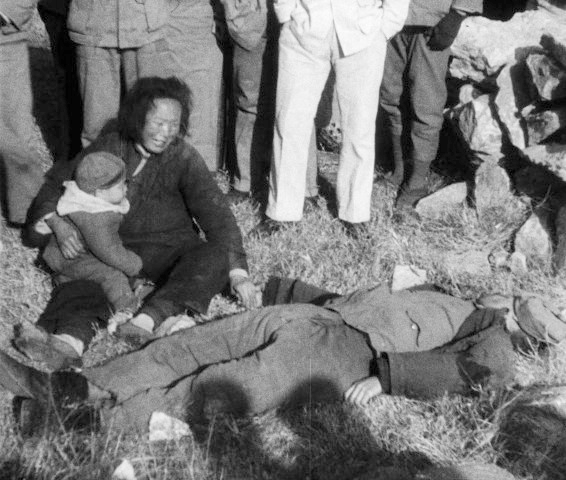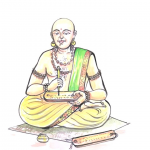The following Post was composed by Navuluri Rao garu. You can follow him on Twitter.

Warfare & Chimeric Peace:
A Literary Review of Angara Venkata Krishna Rao’s novel Viramam
There is a corpus of war literature in other Indian languages, but the cupboard of Telugu literature is near-empty in that genre. “Viramam” has come to fill that void. The novel, set in East Bengal at the time of World War II, encompasses the military life, human-baseness in the throes of war, and appalling living conditions of the common folk crushed between a man-made famine and the demands of war.
This work is born not of a fertile imagination of an armchair writer; Sri Krishna Rao served the military as a havildar during the wartime and the events of his first-hand account sound doubly authentic and convincing.
Another notable feature is: as against the writers of Indian languages generally writing with their regions as backdrop and depicting the lives of those belonging to their own language groups, this novel (set in East Bengal) has no single Telugu character except Rao.
The acclaim the novel won from Narla Venkateswara Rao (V. R. Narla), a doyen of journalism and bilingual writer, may serve as the last word on its merit. Writing in “Books India”, released by the National Book Trust of India in the Fourth National Book Fair (Dec 29, 1970 to Jan 15, 1971), he says:
But Venkata Krishna Rao does not falter or stumble; he proceeds steadily, confidently, in the writing of his war novel, VIRAMAM, for he was a havildar who fought in the Second World War on the Burma Front. He knows war and all its horrors. His plea for the abolition of war is, therefore, wholly sincere, moving, convincing. His is the best and so far the only authentic war novel to appear in Telugu (emphasis added).
Puranam Subrahmanya Sarma, well-known writer, editor of the weeklies Andhra Jyoti and Udayam, and critic, in his foreword to the novel observes:
This Telugu novel, written on the ill-effects of war, is on the same footing as “So Many Hungers” of Bhabani Bhattacharya… It gives a new turn to Telugu literature… In subject, language, style, technique and characterization, “Viramam” is comparable to any of the good novels in other Indian languages… He is of the same class as Bibhuti Bhushan Bandopadyay, Manik Bandopadhyay, T. Sivasankar Pillai, R. K. Narayan, K. N. Subramaniam,….
Serialized in the Andhra Jyoti weekly during 1967-68, it was published by the Visalandhra Book Publishing House in 1970 in book form. In February 2008 it was reprinted by the Jyestha Literary Trust, Visakhapatnam. Rao has to his credit 300 short stories published during 1948-74 and four other notable novels.
Background
Not only for the two world wars that were fought during the first half of the 20th century, for any war there can be any reason. The Ancient History Encyclopedia says that the tribe mentality always results in a dichotomy of an ‘us’ vs. a ‘them’ and engenders a latent fear of the ‘others’ whose culture is at odds with, or at least different from, one’s own. This fear coupled with a desire to expand, or protect, necessary resources, often results in war. It says the word ‘war’ comes to English by the Old High German language word ‘werran’ (to confuse or to cause confusion).
In a study on pre-civilisational wars, 87 per cent of primitive races fought with other races more than one war 65 per cent of races were engaged in un-ending wars. Twelve thousand years ago, a half of the Nubians, who lived between Egypt and Sudan, fell to violence. According to archaeological proofs, among the pre-historic initial wars, one occurred near the Nile. There is a view that war happened 7,000 years ago. Since 5,000 years, however, it had been expansionism that was at the heart of wars. The Zhao war in China dates back to 4,500 years; the Kurukshetra and the Trojan wars to about 3,200 years. In destroying each other both the civilized and the savages are in the same boat, the difference being the kind of weapons used. Probably there is another difference—that of the rapes during wartime.
The murder of Franz Ferdinand, archduke of Austria-Hungary, by a Serbian nationalist on the 28th June 1914 served as a pretext for the Great War, which is also called World War I. The death of a king-designate was an issue of self-respect for Austria-Hungary. The context also was thought to be an opportunity to serve certain other national interests. Into the fight between Austro-Hungary and Serbia, Russia, Germany, France, Britain, America and several other countries were dragged because of variance alliance treaties that existed among them.
In the war that started in 1914 and ended in 1918, lasting four and a half years, 10 million soldiers were dead, 17 million civilians lost their lives and 20 million people were left wounded. The war that was described as “The war to end all wars” sowed seeds for another world war.
Japanese imperialist ambitions as one stream, and Hitler’s racial hatred and German’s wish to avenge the humiliation it had suffered in World War I as the other stream led to another World War. Hitler said that if there were no Jews, let them be invented. The war that started in 1937 lasted eight years and then ended in 1945. A 100 million soldiers took part in it and 50 million people lost their lives, not to speak of the six million Jews who were massacred.
Then came the Cold War between the two camps, during which the world saw the Vietnam War and the Korea War. In 1962, the firing of a missile by the USSR led to the US readying itself for an atomic war. War of one kind or the other has not stopped since then.
The foregoing account of various wars support what the writer of “Viramam” says:
“Human life is an interminable war. Peace is just an interlude. It is of the same kind as the curtain coming down between one act and another of a drama. Even during this brief interregnum the preparation for a war is underway behind the curtain.”
Albert Einstein was reported to have said, “I know not with what weapons World War III will be fought, but World War IV will be fought with sticks and stones.” Obviously he hinted at the destruction of the human civilization if there were to be World War III. Incidentally, caught on the horns of a dilemma the letter he wrote in August 1939 to the President of the USA indirectly goaded him to be prepared with an atomic bomb of its own to counter the Germans. This gave birth to the Manhattan Project that produced three atom bombs in five years. America tested one and exploded two on Japan.


As the novel Viramam is set in Bengal, we need to have a glimpse of the ghastly living (?) conditions that were prevailing at the time of World War II. The moment Japan captured Burma, the whole of Bengal was agog with rumours that its invasion by Japan imminent. The British government was nervous. It implemented the notorious Scorched Earth policy. Anything that would be of use to the Japanese like food and transport were to be made inaccessible. Bengal is full of rivers. The main means of transport is the boat. Nearly 56,000 boats belonging to 500 villages were destroyed. It bought corn and paddy from the poor by deception and transported them from that region for the use of the army to various parts of the world. As the last straw on the weak camel’s back, the Burmese rice that used to meet the Bengal requirement to an extent of 15 per cent was unavailable thanks to the Japanese invasion of Burma. When a request was sent to Winston Churchill by the Secretary of State for India and the Viceroy, he replied, “If food was so scarce, why Gandhi had not died yet?” His other observation was: “The Indians breed like rabbits”. His response typified his government’s attitude to India.

The people, rendered poor, lived on garbage. Even the skinny and bony women with their flesh taking leave of them due to hunger were pounced upon by rapists. In all historical war situations or famines, women had to pay with their bodies. They had to protect themselves from hunger on the one hand and from the rapist on the other. Such humans in name were countless in Bengal then. In 1937, the invading Japanese went on committing atrocities against the Chinese in Nanjing region of China. In addition to children and elderly deaths, 20,000 women were raped.
Composition

Padma, who was pure and innocent, protecting her family by working in the army, was full of love for Kamal. She was full of hope, though anxious, when she appears in the opening chapter of the novel. She was raped by a British soldier. The Kurukshetra was fought to avenge the humiliation of a woman. This cruel war proved to be a curse on women like Padma. In the novel we come across a few more unfortunate women. The 20-year old Gonthi at the Akhaura station; Abdullah’s 19-year old fourth wife Salma; his another wife Razia; Nazibullah’s two daughters; the prostitutes at Brahmabaria; Sheela who works as a duty nurse at the Chittagong advance base hospital; the bodies of women which were lying on the mound near the Akhaura railway station–all these women come under the wheels of the war juggernaut.
The main storyline relates to the love between Padma and Kamal. It is not so lengthy. But we come across it in bits and pieces. In between, we read war news interspersed with the military life and the individual lives of the soldiery. Every character and episode flashes before our eyes like lightning and disappear.
Padma who appears in the first chapter is seen again only in the last chapter; waving her hand to Rao. She looks to be a lightning which hides in itself a thunderbolt. He feels she is India; yes India that was under siege by the British. Padma is a flower; one which was trampled upon by a British military boot. Padma is also the river Padma (as is called by that name in East Bengal). If a river becomes polluted, one has to accuse those who did it; it is not the Padma that has to be ashamed of the pollution, but those who are the perpetrators.
We find in the novel an incident which is both poetic and pathetic. A shepherd boy”, smoking a cigarette given by Rao, sings the song of a love-lorn girl, whose lover was in a far-off land, finally rejecting his love for the logistics reason, “O bides bonthore! Ami tore chaina ..jokhan tore mone ..podee, ta khon tore paaina... Then he shepherds the cattle into the darkness of the forest. Even before they turn their eyes from his side they hear his screams of death. They know he has fallen prey to a tiger.
One is free to have a reservation about the greatness of the novel as compared to other war novels. But, irrefutably, Viramam is the first and, by far, the last Telugu war novel that is authentic as it is written by an insider—and that fact ensures it a niche in Telugu literature.

Disclaimer: This article represents the opinions of the Author, and should not be considered a reflection of the views of the Andhra Cultural Portal. The Author is responsible for ensuring the factual veracity of the content, herein.







ఇధి చాల మంచి వ్యాసము , నవలూరి గారు. ధన్యవాదము ఈ నావలుగురించి మరియు సంగ్రామంలో మహిళా బాధలు గురించి వ్రాశినందుకు. మరో వ్యాసము కి ఏధూరుచూస్తావుంటాము. 😉